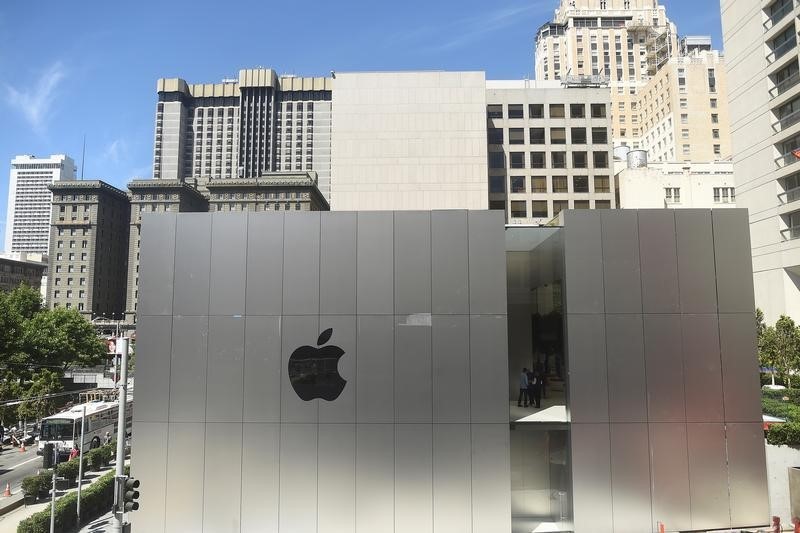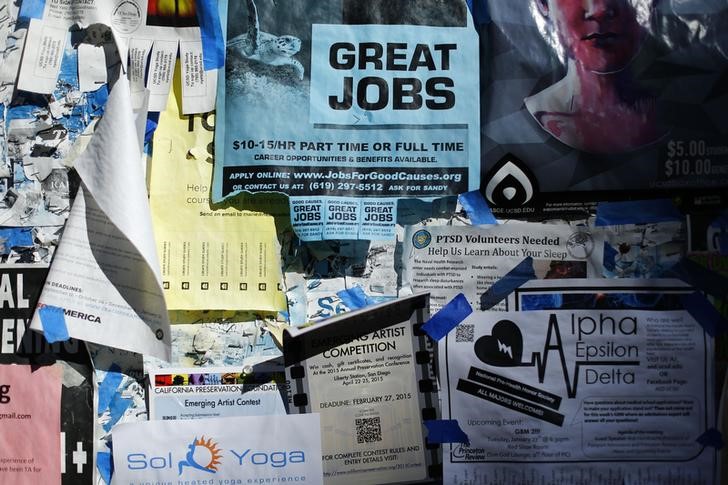By Lucia Mutikani
WASHINGTON (Reuters) - The number of Americans filing for unemployment benefits unexpectedly fell last week, pointing to sustained strength in the labor market despite a sharp slowdown in hiring last month.
Other data on Thursday showed wholesale inventories recording their biggest increase in 10 months in April, prompting economists to raise their second-quarter economic growth estimates. The rise in inventories came even as sales at wholesalers rose for a second straight month.
Initial claims for state unemployment benefits declined 4,000 to a seasonally adjusted 264,000 for the week ended June 4, the Labor Department said. The drop confounded economists' expectations for an increase to 270,000.
"The hand-wringing over the May jobs report may be misplaced," said Joel Naroff, chief economist at Economic Advisors in Holland, Pennsylvania.
Claims have dropped by 30,000 since surging to 294,000 in early May. They have now been below 300,000, a threshold associated with a strong job market, for 66 straight weeks, the longest streak since 1973.
The four-week moving average of claims, considered a better measure of labor market trends as it irons out week-to-week volatility, fell 7,500 to 269,500 last week.
The claims report offered the latest sign that the labor market remains strong even though the economy added only 38,000 jobs in May, the smallest gain since September 2010. A report on Wednesday showed job openings hitting a nine-month high in April and layoffs falling to their lowest level since September 2014.
"The underlying trend to a tighter labor market remains intact. It seems clear that the problem with the jobs market is hiring new employees that are suitable for available positions, which in itself is a sign of labor market tightness," said John Ryding, chief economist at RDQ Economics in New York.
Prices for U.S. Treasuries rose as a broad decline on commodity and stock markets boosted the appeal of low-risk assets. The dollar (DXY) rose against a basket of currencies, while U.S. stocks fell.
ECONOMY REGAINING MOMENTUM
The claims report also showed the number of Americans still receiving benefits after an initial week of aid fell in the week ending May 28 to the lowest level since October 2000. The insured unemployment rate fell one-tenth of a percentage point to a record low of 1.5 percent.
The health of the labor market will likely determine the timing of the next Federal Reserve interest rate increase.
Fed Chair Janet Yellen this week reiterated the U.S. central bank's desire to raise rates, but gave no hints on when that might happen.
Before May's dismal jobs report, Yellen had signaled rates would rise "in coming months" if economic data continued to suggest that growth was picking up in the second quarter. The Fed lifted its benchmark overnight interest rate in December for the first time in nearly a decade.
So far, reports on consumer spending, industrial production and housing suggest the economy has regained speed after growth slowed to a 0.8 percent annualized rate in the first quarter.
Growth prospects for the second quarter received a further boost from a separate report from the Commerce Department on Thursday showing wholesale inventories increasing 0.6 percent in April, the biggest gain since June last year, after rising 0.2 percent in March.
Sales at wholesalers jumped 1.0 percent in April, the largest increase since April 2015, after advancing 0.6 percent in March. With sales increasing solidly for a second straight month, it would take wholesalers 1.35 months to clear shelves, down from 1.36 months in March.
The component of wholesale inventories that goes into the calculation of GDP - wholesale stocks excluding autos - increased 0.8 percent in April. As result, economists raised their second-quarter GDP growth estimates by as much as three-tenths of a percentage point to as high as a 2.7 percent rate.
"While the stronger inventory data should boost growth in the first and second quarters relative to what we previously had been expecting, it also should be more of a headwind for growth in the future," said Daniel Silver, an economist at JPMorgan (NYSE:JPM) in New York.

Inventories have been a drag on GDP growth since the third quarter of 2015.
